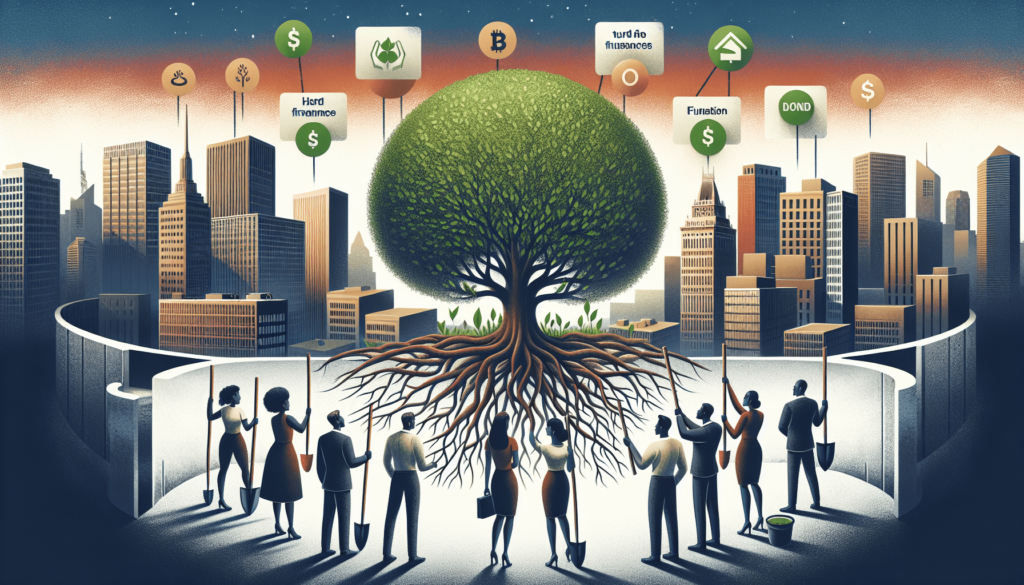In the world of sustainable investment, green bonds have emerged as a promising avenue that not only helps fund environmentally-friendly projects but also offers attractive returns. By investing in green bonds, you can contribute towards a greener future while also enjoying the potential financial benefits. These bonds are a unique financial instrument that raises capital specifically for projects and initiatives that have a positive impact on the environment. With their growing popularity, understanding the benefits of green bonds becomes crucial for anyone looking to invest in a socially responsible and sustainable manner.
What are Green Bonds?
Definition of Green Bonds
Green bonds are financial instruments that are specifically used to finance projects that have a positive environmental impact. These bonds are issued by governments, financial institutions, and corporations to raise capital for projects that promote sustainability, such as renewable energy projects, energy-efficient buildings, clean transportation, and sustainable waste management.
How Green Bonds work
Green bonds work in a similar way to traditional bonds. Investors purchase green bonds, providing the issuer with funds to finance their sustainable projects. These bonds have a predetermined maturity date and interest rate that the investor receives as a return on their investment. The issuer of the bond is committed to using the raised funds exclusively for environmentally friendly projects, as outlined in the bond’s framework.
Types of Green Bonds
There are various types of green bonds available in the market. Some common types include green project bonds, which finance specific projects; green corporate bonds, which finance the issuer’s overall sustainability initiatives; and green municipal bonds, which are issued by local governments to fund environmentally friendly infrastructure projects. Additionally, there are also green retail bonds, which allow individual investors to participate in sustainable investments.
Importance of Sustainable Investment
Addressing climate change
Sustainable investment, including green bonds, plays a crucial role in addressing climate change. By financing projects that reduce greenhouse gas emissions and promote clean energy, green bonds contribute to mitigating the effects of climate change. These investments help shift our economies towards a low-carbon future and support the global transition to renewable energy sources.
Promoting environmental conservation
Green bonds contribute to the conservation of natural resources and the protection of the environment. By financing projects focused on energy efficiency, sustainable agriculture, and conservation of ecosystems, these bonds help reduce environmental degradation and support the preservation of biodiversity.
Social and economic benefits
Investing in sustainable projects through green bonds brings about social and economic benefits. These investments create jobs in clean energy industries, improve public health by reducing pollution, and enhance the overall well-being of communities. Additionally, green bonds also stimulate economic growth by driving innovation, fostering technological advancements, and reducing dependence on fossil fuels.

Benefits of Green Bonds
1. Environmental Impact
One of the primary benefits of green bonds is their positive environmental impact. By financing projects that reduce carbon emissions, promote renewable energy, and improve resource efficiency, these bonds actively contribute to mitigating climate change, protecting natural resources, and preserving ecosystems. Through sustainable investment, green bonds offer a tangible and measurable way to support a greener and more sustainable future.
2. Investor Preferences
Green bonds cater to the growing demand for sustainable investments. Many investors are increasingly seeking opportunities to align their portfolios with their environmental and social values. By providing a dedicated avenue for investing in sustainable projects, green bonds meet the preferences of these environmentally conscious investors and allow them to have a positive impact through their investment choices.
3. Risk Mitigation
Investing in green bonds can help mitigate certain investment risks. By financing environmentally friendly projects, these bonds typically have reduced exposure to carbon-intensive sectors that may face regulatory risks or negative market sentiment. Additionally, green bonds often exhibit enhanced long-term value as the transition to a low-carbon economy gains momentum. This can help stabilize investment returns and provide resilience in times of market volatility.
4. Diversification of Portfolios
Green bonds offer opportunities for diversifying investment portfolios. By including green bonds alongside traditional investments, investors can spread their risk across different asset classes and sectors. This diversification allows for more balanced exposure to various market conditions and potential returns. Moreover, investing in green bonds provides access to new markets and industries that are driving sustainable development, opening up additional investment opportunities.
5. Attracting Institutional Investors
The issuance of green bonds can attract institutional investors, such as pension funds, insurance companies, and asset managers, who have sustainability mandates. These investors often have substantial capital to deploy and are increasingly committed to incorporating environmental, social, and governance (ESG) criteria into their investment strategies. By offering green bonds, issuers can tap into this growing pool of responsible investors and raise significant funds for their sustainable projects.
Environmental Impact
Mitigating climate change
Green bonds contribute directly to mitigating climate change by financing projects that reduce greenhouse gas emissions. For example, these bonds can fund the construction of wind farms, solar power plants, and other renewable energy infrastructure. By supporting these projects, green bonds accelerate the transition to clean energy sources, contributing to the global efforts in combatting climate change.
Promoting renewable energy
One of the key areas of focus for green bonds is the promotion of renewable energy. By financing solar, wind, hydro, and other renewable energy projects, these bonds help reduce our reliance on fossil fuels. This shift towards renewable energy contributes to the diversification of our energy sources, decreases carbon emissions, and spurs technological innovation in the clean energy sector.
Improving resource efficiency
Green bonds also play a crucial role in improving resource efficiency. By funding projects that enhance energy efficiency in buildings, industrial processes, and transportation, these bonds help reduce energy consumption and minimize wasteful practices. This leads to a more sustainable use of resources, lower carbon footprints, and cost savings for businesses and individuals.
Protecting ecosystems
Another significant environmental impact of green bonds is the protection of ecosystems. These bonds finance projects aimed at conserving natural resources, restoring habitats, and preventing environmental degradation. By supporting initiatives such as sustainable forestry, watershed management, and ecosystem restoration, green bonds contribute to the preservation of biodiversity and the resilience of natural ecosystems.

Investor Preferences
Growing demand for sustainable investments
There has been a significant increase in demand for sustainable investments in recent years. Investors are increasingly seeking opportunities that align with their environmental and social values. This demand is driven by a growing awareness of climate change, social inequality, and the need for corporate responsibility. Green bonds provide a dedicated avenue for investors to channel their funds into projects that have a positive impact on the environment and society.
Alignment with environmental and social values
Investing in green bonds allows individuals and institutions to align their portfolios with their environmental and social values. By selecting projects that focus on renewable energy, energy efficiency, and environmental conservation, investors can ensure that their money is contributing to positive change. This alignment provides a sense of purpose and satisfaction, knowing that investments are making a difference in creating a more sustainable future.
Addressing ESG (Environmental, Social, and Governance) criteria
Many institutional investors now incorporate ESG criteria into their investment decision-making process. ESG factors evaluate the environmental, social, and governance performance of companies and projects. Green bonds align with these criteria by funding projects that have a positive impact on the environment, social well-being, and corporate governance practices. This makes green bonds an attractive investment option for institutions committed to responsible investment practices.
Risk Mitigation
Reduced exposure to carbon-intensive sectors
Investing in green bonds can help reduce exposure to sectors that are highly carbon-intensive. As the world transitions to a low-carbon economy, industries heavily reliant on fossil fuels may face regulatory and market risks. By investing in green bonds, which predominantly finance projects aimed at reducing carbon emissions and promoting sustainability, investors can diversify their portfolios and reduce their exposure to these carbon-intensive sectors.
Enhanced long-term value
Green bonds often demonstrate enhanced long-term value due to growing demand for sustainable investments. As the global focus on sustainability intensifies, the value of investments in green projects is expected to increase. By investing early in these projects through green bonds, investors can capture the potential long-term value appreciation. This helps mitigate the risk of investing in industries that may face declining returns due to environmental concerns and changing consumer preferences.
Stabilizing investment returns
Investing in green bonds can provide stability to investment returns, particularly during times of market volatility. Sustainable projects financed by green bonds often have a predictable revenue stream, such as renewable energy production or energy efficiency savings. These revenue streams can provide a consistent and stable cash flow, which helps reduce the volatility typically associated with traditional investments. This stability can be particularly appealing to investors seeking a more risk-averse approach.
Increased resilience of projects and companies
Sustainable projects financed by green bonds often demonstrate a greater level of resilience compared to their non-sustainable counterparts. These projects are designed to thrive in a changing environmental and regulatory landscape, making them less susceptible to the risks associated with climate change and shifting market dynamics. By investing in green bonds, investors can benefit from the increased resilience of these projects and companies, which can contribute to more consistent and reliable returns.
Diversification of Portfolios
Expanding investment options
Including green bonds in investment portfolios expands the range of available investment options. By diversifying into sustainable investments, investors can allocate their funds across a broader range of asset classes and industries. This diversification helps reduce the risk associated with investing in a single sector or asset class. Green bonds offer a unique opportunity to invest in projects that are directly linked to pressing global challenges, providing an additional avenue for potential returns.
Opportunity to balance risks and returns
Investing in green bonds allows for the balancing of risks and returns within a portfolio. As with any investment, green bonds carry their own unique risks. However, by including green bonds alongside traditional investments, investors can achieve a more balanced risk profile. The relatively stable returns offered by green bonds, combined with potentially higher returns from other investments, can help manage portfolio risks while still capitalizing on the potential benefits of sustainable investments.
Accessing new markets
Green bonds provide access to new markets and industries that are driving sustainability. By investing in these bonds, investors can tap into the growing global demand for renewable energy, energy-efficient technologies, and green infrastructure. This exposure to emerging markets and industries diversifies investment portfolios and provides opportunities to capitalize on the transition towards a sustainable economy.
Reducing concentration risks
Investment portfolios that are heavily concentrated in a single sector or asset class can be vulnerable to specific risks. By including green bonds in portfolios, investors can reduce concentration risks associated with traditional investments. Green bonds offer exposure to projects and industries that are designed to be environmentally friendly and sustainable, serving as a hedge against risks associated with carbon-intensive sectors and industries that may face increasing scrutiny and regulations.
Attracting Institutional Investors
Meeting sustainability goals
Institutional investors, such as pension funds, insurance companies, and sovereign wealth funds, often have specific sustainability goals or mandates. They aim to channel their funds into investments that align with their environmental and social objectives. Green bonds provide a compelling option for these institutional investors to meet their sustainability goals and requirements. By investing in green bonds, these institutions can effectively allocate capital towards projects that promote sustainability and contribute to their responsible investment strategies.
Enhancing reputation
Investing in green bonds can enhance the reputation of issuers. Companies and governments that issue green bonds demonstrate their commitment to sustainability and responsible business practices. This commitment enhances their reputation among investors, customers, and other stakeholders. By publicly supporting sustainable projects through green bonds, issuers can differentiate themselves as environmentally conscious and gain the trust and support of the investment community.
Aligning with responsible investment principles
Green bonds align with responsible investment principles, which are becoming increasingly important for institutional investors. These principles consider not only financial returns but also the broader impact of investments on the environment and society. By offering green bonds, issuers demonstrate their alignment with responsible investment practices and attract institutional investors who prioritize ESG factors as part of their investment decision-making process. This alignment can lead to long-term partnerships and increased capital inflows.
Market Growth and Potential
Global trends in green bond issuance
The market for green bonds has experienced significant growth in recent years. According to the Climate Bonds Initiative, global green bond issuance reached a record high of over $270 billion in 2020. This growth reflects the increasing interest and demand for sustainable investing. As governments, corporations, and financial institutions commit to ambitious climate and sustainability goals, the issuance of green bonds is expected to continue its upward trajectory, opening new opportunities for sustainable investments.
Investment opportunities
The green bond market provides a diverse range of investment opportunities across various sectors and industries. These opportunities span renewable energy projects, sustainable infrastructure, green buildings, clean transportation, and more. Additionally, the market offers investment options in different regions around the world, allowing investors to diversify their portfolios geographically. With the increasing focus on sustainable development, the green bond market presents attractive opportunities for investors seeking both financial returns and positive environmental impact.
Potential for market expansion
The potential for market expansion in the green bond sector is significant. As governments and international organizations increase their commitments to sustainability, there is a growing need for financing sustainable projects. Green bonds provide a well-structured and transparent mechanism for raising capital in support of these projects. Moreover, as investor demand for sustainable investments continues to rise, the market for green bonds is likely to expand further, attracting more issuers and unlocking additional investment opportunities.
Conclusion
In conclusion, green bonds offer a compelling investment option for individuals and institutions looking to contribute to sustainable development while achieving financial returns. These bonds provide a way for investors to make a positive impact on the environment and society by financing projects that mitigate climate change, promote renewable energy, improve resource efficiency, and protect ecosystems. The benefits of green bonds extend to investors as well, with advantages such as environmental impact, alignment with investor preferences, risk mitigation, diversification of portfolios, and attraction of institutional investors. The green bond market is experiencing rapid growth and shows great potential for further development, providing ample opportunities for sustainable investment and the financing of projects that contribute to a greener and more sustainable future. By embracing green bonds, investors can combine financial objectives with environmental and social goals, making a difference in the transition towards a more sustainable and resilient world.

